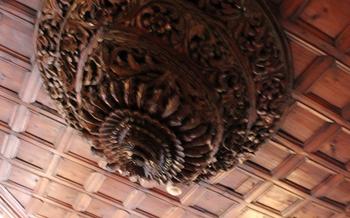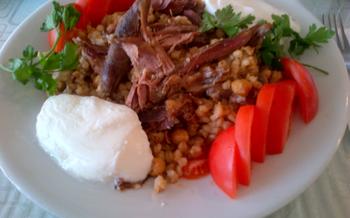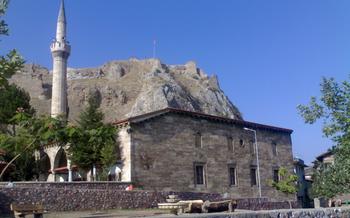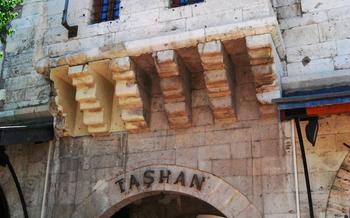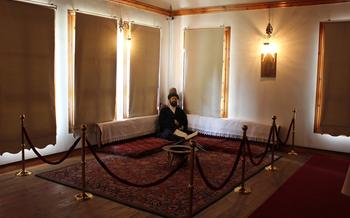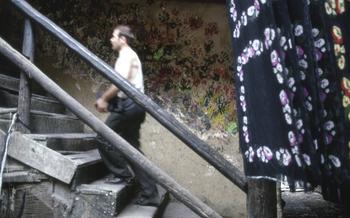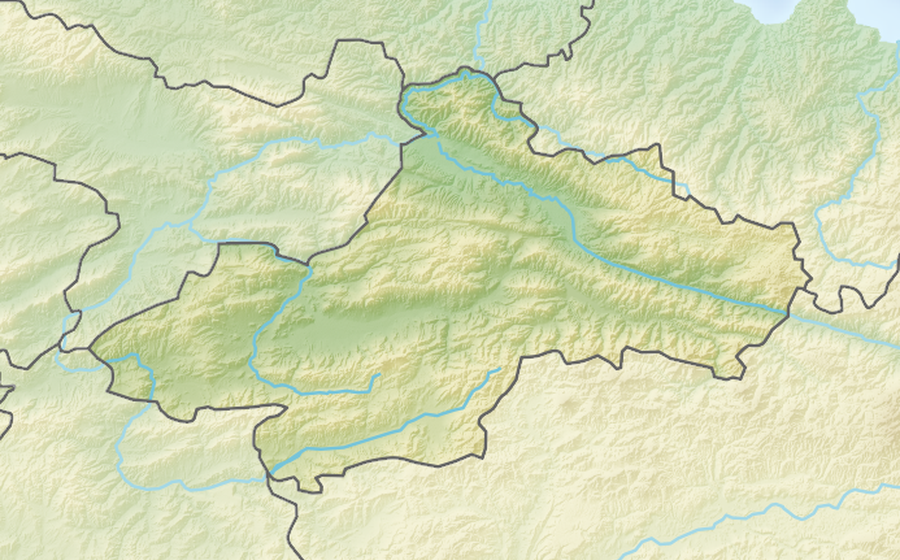
Dördüzlü Kümbet (Tomb of the Four)
- Atop the Hill: A Historical Overview
- A Journey Through Time: Exploring the Complex
- Guardians of History: The Epitaphs
- A Place of Serenity: The Courtyard
- A Masterpiece of Seljuk Architecture: The Domed Ceilings
- Symbolism in Stone: The Tomb's Exterior
- A Place of Pilgrimage: The Tomb's Religious Significance
- A Living Legacy: The Tomb's Impact on Tokat
- A Timeless Treasure: The Tomb's Preservation
- A Photographer's Paradise: Capturing the Tomb's Beauty
- A Haven for History Buffs: Exploring the Tomb's Surroundings
- Practicalities: Planning Your Visit
- A Culinary Journey: Savoring Tokat's Delights
- A Memento to Remember: Shopping in Tokat
- Insider Tip: Unveiling Hidden Gems
Atop the Hill: A Historical Overview
Nestled atop a picturesque hill in the heart of Tokat, Turkey, stands the Dördüzlü Kümbet, a testament to the city's rich cultural heritage. This awe-inspiring mausoleum, commonly known as the Tomb of the Four, invites visitors on a journey through time, revealing the grandeur of Seljuk architecture and the fascinating stories of those laid to rest within its sacred walls.
The Dördüzlü Kümbet was constructed during the 13th century under the patronage of the Seljuk Sultanate, a dynasty that ruled over a vast empire in the Middle East. The Seljuks, known for their architectural prowess, left an indelible mark on Tokat, transforming it into a vibrant center of Islamic culture. The tomb stands as a symbol of their enduring legacy, showcasing the intricate craftsmanship and artistic sensibilities that characterized Seljuk architecture.
The Dördüzlü Kümbet's architectural style is a blend of Seljuk and Anatolian influences, featuring a distinctive octagonal shape and intricate carvings that adorn its exterior. The tomb's octagonal shape holds symbolic significance, representing the eight gates of paradise in Islamic tradition. The exterior is adorned with exquisite decorative elements, including geometric patterns, calligraphic inscriptions, and vegetal motifs, showcasing the Seljuks' mastery of stone carving.
The tomb's primary purpose was to serve as a resting place for four notable individuals who played significant roles in Tokat's history. These individuals, who remain shrouded in mystery, are believed to have been influential figures in the city's religious, political, or military spheres. Their contributions to Tokat's development earned them the honor of being interred in this grand mausoleum, which stands as a tribute to their legacy.
A Journey Through Time: Exploring the Complex
As you step through the grand entrance of the Dördüzlü Kümbet, you are transported back in time to an era of architectural splendor. The complex consists of four separate tombs, each housing the remains of a revered figure from Tokat's past. The tombs are arranged symmetrically around a central courtyard, creating a harmonious and serene atmosphere.
Intricate carvings and inscriptions adorn the walls of the tombs, telling the stories of the individuals laid to rest within. The epitaphs, written in elegant calligraphy, provide valuable insights into their lives and contributions to society. The surrounding courtyard, with its lush greenery and decorative elements, adds to the overall beauty and tranquility of the complex.
Guardians of History: The Epitaphs
The Dördüzlü Kümbet stands as a testament to the lives and contributions of four remarkable individuals. Their stories, etched in stone, offer a glimpse into the past and shed light on the rich history of Tokat. Each tomb bears an epitaph, a poetic inscription that immortalizes the deceased and their legacy.
Translating these epitaphs is a task that requires not only linguistic expertise but also a deep understanding of Islamic culture and history. The inscriptions, often written in intricate calligraphy, reveal the names, titles, and accomplishments of those buried within. They provide valuable insights into the social, political, and religious climate of the Seljuk era.
The individuals commemorated in the Dördüzlü Kümbet were not merely ordinary citizens. They were scholars, statesmen, military commanders, and spiritual leaders who left an indelible mark on their society. Their contributions ranged from advancing knowledge and education to defending the realm and promoting justice.
The calligraphy itself, with its graceful lines and intricate patterns, is a work of art in its own right. It serves as a reminder of the importance of Islamic calligraphy as a form of artistic expression and a means of preserving knowledge and history.
A Place of Serenity: The Courtyard
The courtyard surrounding the Dördüzlü Kümbet exudes an air of tranquility and serenity, inviting visitors to pause and reflect amidst its architectural beauty. The courtyard's central feature is a large, octagonal pool, whose still waters reflect the intricate carvings of the tomb's exterior. The pool is surrounded by a walkway paved with smooth stones, creating a harmonious contrast to the intricate patterns adorning the tomb's walls.
The courtyard is enclosed by a series of arches supported by slender columns, creating a sheltered space that enhances the sense of peace and seclusion. The arches are adorned with delicate carvings and geometric designs, casting intricate shadows that dance across the courtyard throughout the day.
The courtyard's serene atmosphere is further enhanced by the presence of several trees and shrubs, providing shade and a touch of greenery to the space. The courtyard's layout and design create a harmonious balance between the architectural elements and the natural surroundings, fostering a sense of tranquility that invites visitors to linger and contemplate the beauty of the tomb and its surroundings.
A Masterpiece of Seljuk Architecture: The Domed Ceilings
The interiors of the Dördüzlü Kümbet are adorned with magnificent domed ceilings, a testament to the exceptional craftsmanship of the Seljuk artisans. These domes are not merely structural elements but intricate works of art, showcasing a harmonious blend of aesthetics and symbolism.
The ceilings are adorned with intricate designs and patterns, each meticulously carved with precision. The use of muqarnas, a form of ornamental vaulting, creates a mesmerizing effect, resembling a honeycomb of stalactites. These muqarnas seamlessly transition into the domes, creating a sense of fluidity and movement.
The symbolism associated with the domes is profound. In Islamic architecture, domes often represent the heavens, symbolizing the divine realm and the connection between the earthly and spiritual worlds. The intricate patterns and designs on the domes are believed to reflect the beauty and complexity of the heavens, inviting contemplation and a sense of awe.
Moreover, the acoustics within the tomb are carefully designed to enhance the spiritual atmosphere. The domed ceilings act as resonators, amplifying and reverberating sounds, creating an immersive auditory experience. This acoustic effect is particularly noticeable during prayers and recitations, fostering a sense of connection and devotion among the visitors.
Symbolism in Stone: The Tomb's Exterior
The octagonal shape of the tomb is not merely a design choice but holds profound symbolism. In Islamic architecture, the octagon often represents the Eight Gates of Paradise, emphasizing the tomb's connection to the afterlife.
The number four also carries significance, representing the four directions or the four elements of earth, water, fire, and air. This symbolism reinforces the tomb's connection to the natural world and the cycle of life and death.
Decorative elements on the tomb's exterior further enhance its symbolism. Intricate geometric patterns evoke the perfection and order of the divine, while floral motifs represent paradise and the beauty of the afterlife.
The play of light and shadow on the tomb's exterior adds another layer of symbolism. As the sun moves throughout the day, the tomb's appearance changes, creating a dynamic interplay of light and dark. This effect symbolizes the transition from life to death and the eternal nature of the soul.
A Place of Pilgrimage: The Tomb's Religious Significance
In Islamic tradition, the veneration of saints and holy figures holds a significant place. The Dördüzlü Kümbet, with its association with four revered individuals, has become a site of pilgrimage for Muslims from near and far. Pilgrims visit the tomb to pay their respects, seek blessings, and establish a spiritual connection with the departed.
The tomb serves as a reminder of the transient nature of life and the importance of seeking guidance and inspiration from those who have come before. It is believed that visiting the tombs of holy figures brings blessings and spiritual rewards, as it is seen as a way of honoring their memory and seeking their intercession.
The tomb's religious significance is further enhanced by its serene and contemplative atmosphere, which invites visitors to engage in prayer and devotion. The intricate carvings and inscriptions, with their verses from the Quran and references to the lives of the saints, create a spiritual ambiance that encourages reflection and remembrance.
For many Muslims, visiting the Dördüzlü Kümbet is a way to connect with their faith and seek blessings and guidance from those who have dedicated their lives to serving God and humanity. The tomb's religious significance is a testament to the enduring power of faith and the enduring legacy of the saints and holy figures who continue to inspire and guide generations of believers.
A Living Legacy: The Tomb's Impact on Tokat
The Dördüzlü Kümbet stands as a testament to Tokat's rich and storied past, serving as a symbol of the city's cultural heritage. Its enduring presence has played a pivotal role in promoting cultural tourism, attracting visitors from far and wide who seek to delve into the depths of Turkey's Seljuk legacy.
The tomb's significance extends beyond its historical value, as it has become an integral part of the local economy. The influx of tourists drawn to this architectural marvel has created employment opportunities and supported local businesses, particularly those involved in the hospitality and tourism sectors.
Moreover, the Dördüzlü Kümbet instills a sense of pride and identity among the people of Tokat. It serves as a tangible reminder of the city's contributions to Islamic architecture and culture, fostering a deep connection to their roots and heritage. The tomb's enduring presence acts as a source of inspiration, reminding the community of the achievements of their ancestors and encouraging them to preserve and celebrate their rich cultural legacy.
A Timeless Treasure: The Tomb's Preservation
The Dördüzlü Kümbet stands as a testament to the enduring legacy of Seljuk architecture and Tokat's rich history. However, preserving this architectural masterpiece requires diligent efforts to maintain its integrity and ensure its continued existence for future generations.
The challenges of preserving the tomb are multifaceted. Time, weather, and environmental factors can take their toll on the structure, causing wear and tear. Additionally, the tomb's popularity as a tourist destination means that it is subject to foot traffic and potential damage.
Conservation efforts play a crucial role in safeguarding the tomb's structural integrity and preserving its intricate details. Regular maintenance, repairs, and restoration work are essential to address any signs of deterioration and prevent further damage. These efforts may involve cleaning and repairing the exterior stonework, maintaining the stability of the domes, and preserving the delicate carvings and inscriptions.
The preservation of the Dördüzlü Kümbet is not just a matter of maintaining a historical monument but also of safeguarding a cultural heritage that holds immense significance for Tokat and the region. By ensuring the tomb's longevity, we preserve a tangible link to the past and ensure that future generations can continue to appreciate and learn from this architectural gem.
A Photographer's Paradise: Capturing the Tomb's Beauty
The Dördüzlü Kümbet is a photographer's dream, offering endless opportunities to capture its architectural splendor and intricate details. Whether you're an amateur enthusiast or a seasoned professional, the tomb's beauty will undoubtedly inspire your creativity.
Tips for Capturing the Best Shots:
-
Golden Hour Magic: Visit during the golden hours of sunrise or sunset to capture the tomb's exterior bathed in a warm, ethereal glow. The soft, diffused light will enhance the structure's textures and colors, creating a captivating scene.
-
Experiment with Perspectives: Don't limit yourself to frontal shots. Circle the tomb, exploring different angles and perspectives. Try capturing the tomb's height by shooting from a low angle, or emphasize its grandeur by shooting from a distance.
-
Details Make the Difference: Zoom in on the intricate carvings, inscriptions, and decorative elements that adorn the tomb. These details add depth and character to your photographs, showcasing the craftsmanship and artistry that went into its creation.
-
Play with Light and Shadow: The interplay of light and shadow creates dramatic effects, especially during the early morning or late afternoon. Position yourself to capture the shadows cast by the tomb's domes and arches, adding depth and dimension to your shots.
-
Embrace the Seasons: Each season offers a unique perspective. In spring, the surrounding greenery provides a vibrant backdrop, while in winter, the snow-covered tomb exudes a serene and majestic charm.
Remember, the key to capturing stunning photographs is patience and experimentation. Take your time, explore different angles, and let the tomb's beauty guide your creativity.
A Haven for History Buffs: Exploring the Tomb's Surroundings
Beyond the Dördüzlü Kümbet itself, Tokat offers a wealth of historical attractions that will captivate any history enthusiast. A short walk from the tomb, the Tokat Museum houses an impressive collection of artifacts and exhibits that provide a glimpse into the city's rich past. From ancient pottery and coins to traditional textiles and manuscripts, the museum offers a comprehensive journey through Tokat's history and culture.
Strolling through the city's streets, visitors will encounter numerous Ottoman-era landmarks that speak to Tokat's architectural heritage. The Grand Mosque, with its elegant dome and minarets, is a testament to the city's devotion to faith, while the Tokat Citadel, perched on a hilltop, offers panoramic views and a fascinating glimpse into the city's fortifications.
For a deeper dive into Tokat's history, consider exploring some of the lesser-known historical sites that lie just off the beaten path. The Armenian Church, with its intricate frescoes and stained-glass windows, offers a glimpse into Tokat's diverse religious heritage, while the Tokat Clock Tower, with its unique blend of Ottoman and European architecture, stands as a symbol of the city's cosmopolitan past.
To fully immerse yourself in Tokat's history, don't hesitate to engage with the friendly locals. They will be more than happy to share their knowledge, stories, and insights about their beloved city, providing you with a truly authentic and unforgettable experience.
Whether you're a seasoned history buff or simply curious about the past, Tokat has something to offer every traveler. From the grandeur of the Dördüzlü Kümbet to the hidden gems scattered throughout the city, Tokat is a true haven for those who seek to delve into the depths of history.
Practicalities: Planning Your Visit
The Dördüzlü Kümbet stands as a testament to history, inviting travelers to immerse themselves in its rich legacy. To ensure a fulfilling visit, here are some practical considerations:
-
Location and Accessibility: The tomb is situated in the heart of Tokat, easily accessible on foot or by public transportation. Its central location makes it a convenient stop while exploring the city's other historical attractions.
-
Opening Hours and Admission Fees: The tomb is open to visitors daily, with extended hours during the summer season. Admission fees are nominal, allowing for an affordable cultural experience.
-
Dress Code and Respectful Behavior: As a sacred site, visitors are expected to dress modestly and behave respectfully. This includes avoiding loud noises and maintaining a contemplative atmosphere within the tomb's premises.
-
Tips for Visiting: To fully appreciate the tomb's beauty, plan your visit during the golden hours of sunrise or sunset when the play of light and shadow enhances its architectural features. Also, consider visiting during the off-season to avoid crowds and enjoy a more intimate experience.
A Culinary Journey: Savoring Tokat's Delights
Indulge in the flavors of Tokat, a city where culinary traditions intertwine to create a rich tapestry of tastes and aromas.
Tokat's cuisine reflects its diverse heritage, with influences from Turkish, Ottoman, and Central Asian culinary traditions. Savor the delectable flavors of keşkek, a hearty dish made from pounded wheat, meat, and spices, or tantalize your taste buds with Tokat kebabı, a succulent skewer of grilled meat served with aromatic rice and grilled vegetables.
Don't miss the opportunity to try Tokat's famous börek, a flaky pastry filled with cheese, potatoes, or minced meat. For a sweet treat, indulge in Tokat's güllaç, a delicate dessert made from layers of filo pastry soaked in rosewater syrup and topped with crushed walnuts.
Embark on a culinary adventure by visiting Tokat's local markets and bazaars, where you can find an array of fresh produce, spices, and traditional Turkish delights. Immerse yourself in the vibrant atmosphere as you haggle for the best prices and discover hidden culinary treasures.
Savor the aromatic flavors of Turkish coffee, a national beverage deeply ingrained in the country's culture. Sip on a cup of freshly brewed coffee while enjoying the lively ambiance of a traditional kahve. Indulge in the comforting warmth of Turkish tea, a symbol of hospitality and friendship, often served with a side of sweet treats.
Tokat's culinary experiences are not just about satisfying your taste buds but also about immersing yourself in the city's rich cultural heritage. Embark on a culinary journey that will leave you with lasting memories and a deep appreciation for the diverse flavors of Tokat.
A Memento to Remember: Shopping in Tokat
Tokat offers a delightful shopping experience for those seeking unique souvenirs and traditional handicrafts. Stroll through the vibrant local markets and bazaars to discover an array of treasures. From intricate carpets and handwoven textiles to exquisite pottery and copperware, there's something for every taste. Bargaining is a cultural norm, so don't hesitate to engage in friendly negotiations with the vendors. This not only allows you to secure a good deal but also fosters a deeper connection with the local artisans. By supporting the local economy through your purchases, you contribute to the preservation of Tokat's rich cultural heritage.
Insider Tip: Unveiling Hidden Gems
Beyond the Dördüzlü Kümbet, Tokat holds a treasure trove of hidden historical gems waiting to be discovered. Explore the atmospheric Bezirhane, a 16th-century textile factory that showcases the city's rich artisanal heritage. Admire the intricate carvings of the Taş Mescit, a small but exquisite mosque tucked away in the old town. For a glimpse into Tokat's Ottoman past, visit the elegant Hüsnü Paşa Konağı, a restored mansion that now serves as a museum.
Venture off the beaten path to uncover lesser-known sites like the historic Tokat Castle, perched atop a hill overlooking the city. Explore the remains of its fortifications and soak in the panoramic views. Seek out the hidden gems by engaging with locals, who can provide invaluable insights into the city's lesser-known treasures.
By uncovering these hidden gems, you'll gain a deeper appreciation for Tokat's rich history and cultural heritage. Embrace the opportunity to create a truly immersive and authentic experience that will leave you with lasting memories of this captivating city.
